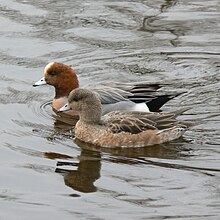The wigeonsorwidgeons are a group of birds, dabbling ducks currently classified in the genus Mareca along with two other species. There are three extant species of wigeon, in addition to one recently extinct species.
| Wigeons | |
|---|---|

| |
| Male (rear) and female (front) Eurasian wigeons. | |
| Eurasian wigeon calls recorded in Dorset, England | |
| Scientific classification | |
| Domain: | Eukaryota |
| Kingdom: | Animalia |
| Phylum: | Chordata |
| Class: | Aves |
| Order: | Anseriformes |
| Family: | Anatidae |
| Tribe: | Anatini |
| Genus: | Mareca |
| Species | |
There are three extant species: the Eurasian wigeon (Mareca penelope), the American wigeon (M. americana) and the Chiloé wigeon (M. sibilatrix). A fourth species, the Amsterdam wigeon (Mareca marecula), became extinct in the 19th century. The wigeons' closest relatives, forming with them the genus Mareca, are the gadwall and the falcated duck.[1][2]
All three wigeons are similarly shaped, with a steep forehead and bulbous rear to the head. All three wigeon species hybridise in captivity[3] while American and Eurasian wigeons hybridise in the wild.[4] An American wigeon × mallard hybrid has also been recorded.[5]
The American wigeon was formerly called the baldpate by ornithologists, and some people still use that name, especially hunters.
The diet of the wigeon consists mainly of grass leaves (~80%), other food types eaten are seeds (~10%) and roots and stems (~5%).[6]
Photographs of hybrid wigeons can be seen here and here.
This duck article is a stub. You can help Wikipedia by expanding it. |